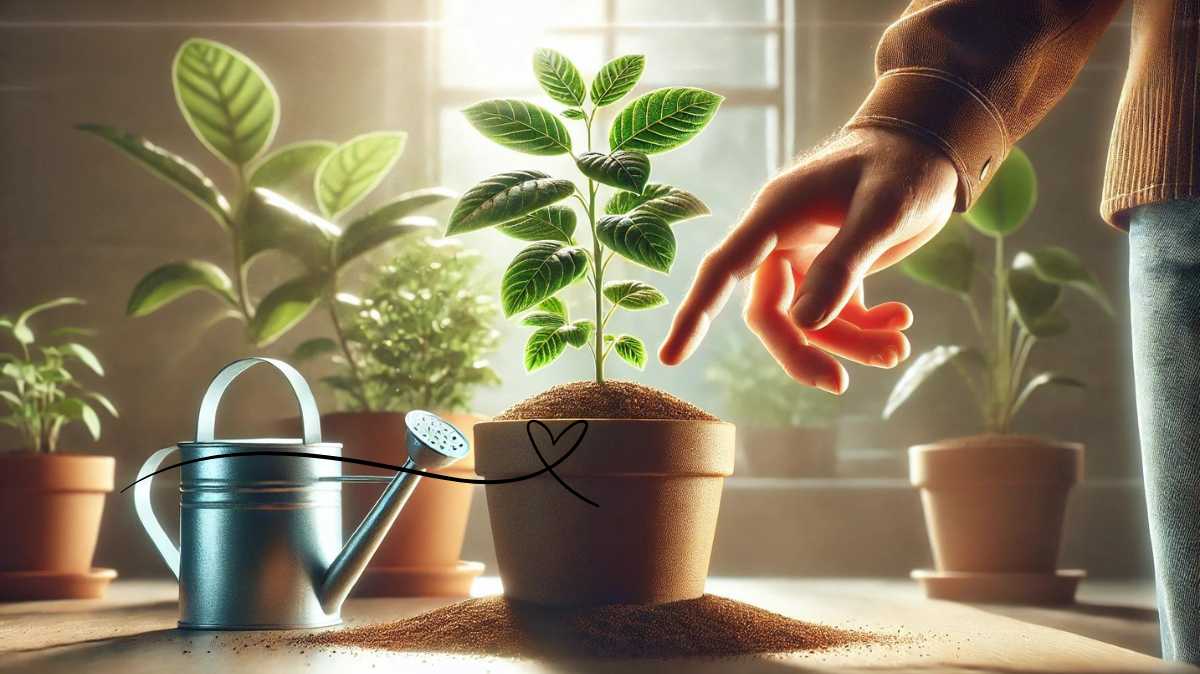Ever wondered if you’re watering your plants the right way? Trust me, I’ve been there. I’ve killed a fair share of houseplants from both overwatering and neglect. But over time, I learned to listen to my plants (figuratively, of course) and now my watering game is spot on. Whether you’re a newbie or have a growing jungle at home, these 8 foolproof tips will help you determine the perfect time to water.
Table of Contents
1. How Dry is Too Dry? Try the Finger Test
Wondering how to check your plant’s thirst level? The finger test is as easy as it gets. Stick your finger about 2 inches into the soil. If it feels dry, your plant is thirsty. But if there’s still moisture, hold off. Some plants, like snake plants, prefer a bit of dry time, while tropical varieties love consistency. Pro tip: the deeper you test, the better you understand how moisture distributes in the pot.
2. Pot Weight: A Clever Trick You Can’t Ignore
You might not think much of pot weight, but it’s a game-changer. Lift your plant after watering and again when it’s dry—notice a difference? When the pot feels lighter than usual, it’s probably time to water. This technique is especially helpful for larger plants where checking the soil can be tricky. It may take a bit of practice, but soon enough, you’ll master this simple yet reliable method.
3. Wilting Leaves: A Cry for Help
If your plant’s leaves are drooping, it’s likely too dry. But here’s the kicker—wilting can also be a sign of overwatering. So, don’t just jump to conclusions! Check the soil first. If it’s dry, give your plant a good soak. If it’s still moist, wait and monitor. I’ve learned the hard way that both underwatering and overwatering lead to similar symptoms, so always double-check. For a complete guide on how to water your plants without risking either extreme, check out this resource on How to Water Plants Properly: Tips and Techniques.
4. Use a Skewer for Deep Soil Insights
Not sure what’s going on below the surface? Grab a wooden skewer, chopstick, or pencil. Stick it deep into the soil, wait a minute, then pull it out. If the skewer is dry, your plant needs water. If it’s still damp, hold off. This method is especially handy for larger pots where surface checks don’t always tell the full story.
5. What Do Your Plant’s Leaves Say?
Discolored or curling leaves? Yellowing usually points to overwatering, while crispy, brown edges mean your plant is parched. However, be cautious—other factors like temperature and light can also cause these symptoms. I learned that getting to know your plant’s habits will help you avoid these issues in the future. Keep track of leaf health, and make adjustments based on what you see.
6. Invest in a Moisture Meter (It’s Worth It!)
I used to be skeptical of moisture meters, but they’ve totally transformed how I care for my plants. These handy tools take the guesswork out of watering by giving you a real-time reading of soil moisture levels. Stick it in the pot, and you’ll know instantly if it’s dry or too wet. It’s especially great for plants that require precise conditions like orchids or peace lilies.
7. Leaf Drop: An Underestimated Sign
While some leaf drop is normal, especially for older leaves, if you notice new or young leaves dropping off, your plant may be thirsty. It’s a common issue with plants like ficus or pothos. Whenever I see a sudden increase in leaf drop, I do a quick soil check—if it’s dry, a good drink usually perks things up.
8. Soil Color: Visual Cues to Look For
Ever noticed that soil looks darker when it’s wet? Use that visual clue to your advantage. If the soil is still dark and rich-looking, it’s probably moist. If it’s pale and dry, it’s time to water. Combine this with the finger test for even better accuracy. This trick won’t work for all plants, but it’s a helpful starting point.
Final Thoughts: Learn to Read Your Plants
Knowing when to water a plant is a skill, and just like any skill, it improves over time. I’ve learned that each plant has its own preferences, and the key is observation. Trust your instincts, use these tips, and soon you’ll be watering with confidence.
FAQs About Watering Plants
1. How do I avoid overwatering my plants?
Stick to checking soil moisture rather than watering on a schedule. Overwatering is often due to routine-based watering rather than the plant’s actual needs.
2. What’s the best time of day to water plants?
Morning is best. Watering early in the day allows the soil to absorb moisture before the sun evaporates it.
3. Should I mist my plants?
Misting is great for tropical plants that love humidity, like ferns. But avoid misting succulents or cacti.
4. Can I use tap water?
Most plants are fine with tap water, but some sensitive varieties prefer filtered or distilled water to avoid mineral buildup.
5. How often should I water my plants in winter?
In winter, plants usually need less water due to slower growth. Always check soil moisture before watering.
Looking for more plant care tips? Check out this detailed guide on houseplant watering mistakes. Happy gardening!
Author

An aspiring business leader, I am working towards my dream of graduating from Stanford University with a degree in Business Management. Passionate about sharing knowledge, I strive to empower others through education and collaborative learning.
View all posts


